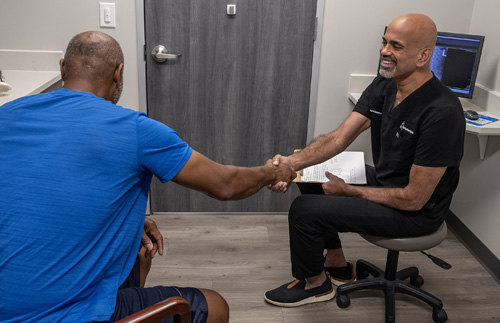Discography
What Are The Discs?
The discs are soft, cushion-like pads which separate the hard vertebral bones of your spine. A disc may be painful when it bulges, herniates, tears or degenerates and may cause pain in your neck, mid-back, low back and arms, chest wall, abdomen and legs. Other structures in your spine may also cause similar pain such as the muscles, joints and nerves. Usually, we have first determined that these other structures are not your sole pain source (through history and physical examination, review of x-rays, CT’s/MRI’s and other diagnostic injection procedures such as facet and sacroiliac joint injections and nerve root blocks) before performing discography.

What Is Discography And Why Is It Helpful?
Discography confirms or denies the disc(s) as a source of your pain. This procedure utilizes the placement of a needle into the discs themselves and injecting contrast (dye). CT’s and MRI scans only demonstrate anatomy and cannot absolutely prove your pain source. In many instances, the discs may be abnormal on MRI or CT scans but not be a source of pain. Only discography can tell if the disc itself is a source of your pain. Therefore discography is done to identify painful disc(s) and help the surgeon plan the surgery or avoid surgery that may not be beneficial. Discography is usually done only if you think your pain is significant enough for you to consider surgery.
What Will Happen To Me During The Procedure?
An IV will be started so that antibiotics (to prevent infection) and relaxation medication can be given. You will lie on your back for cervical discography and on your side for both thoracic and lumbar discography. The skin will be scrubbed using 2 types of sterile scrub (soap). Next, the physician will numb a small area of skin with numbing medicine. This medicine stings for several seconds. After the numbing medicine has been given time to be effective, your doctor will direct a small needle using x-ray guidance into the disc(s) space. You may feel a temporary discomfort as the needle passes through the muscle or near a nerve root. Your doctor may perform this at more than one disc level. After the needles are in their proper locations, a small amount of contrast (dye) is injected into each disc.

What Will Happen After The Procedure?
Immediately afterwards you will be taken to Cat Scan where additional pictures will be taken. Then you will go back to the recovery area where you will be monitored for 30-60 minutes. You may be given a prescription for pain medication over the next 2-3 days, for muscle discomfort that may exist after this procedure. You will not be able to drive the day of your procedure.
General Pre/Post Instructions
You should eat a light meal within a few hours before your procedure. If you are an insulin dependent diabetic, do not change your normal eating pattern prior to the procedure. Please take your routine medications (ie. high blood pressure and diabetic medications). If your are on Coumadin (blood thinners) or Glucophage (a diabetic medicine) you must notify this office so the timing of these medications can be explained. You will be at the hospital approximately 3-4 hours for your procedure. You will need to bring a driver with you. You may return to your normal activites 1-2 days after the procedure, including returning to work.

Spine Physicians Institute treats back pain, neck pain, herniated discs, stenosis and other spine problems. Patients come to the spine center from across the Dallas-Fort Worth metroplex. Dr. Sethuraman is one of few Mayo Clinic fellowship-trained spine surgeons in the North Texas area. A fellowship is the highest level of medical education in the U.S.
